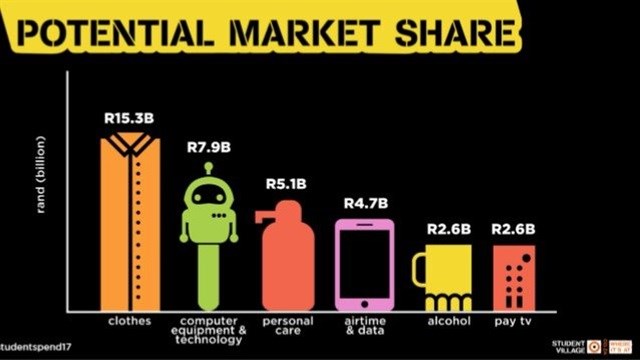#YouthMarketing: The importance of brand “Me”

The key objective was to understand how students spend their money, whose money they spend and their relationship with credit. In this year’s survey, there was a significant increase in retail card expenditure and utilisation. They are mainly spending their money on clothing, accessories, cosmetics and toiletries.
While they are ambitious and want wealth, significant resources, time and money is also being spent by students in making a brand name for themselves, solidifying “brand Me”.
According to Student Village, students continue to play an influential role on South Africa’s GDP, but the recent economic downturn has had a direct impact on how students are spending their money.
Marc Kornberger, co-founder and managing director of Student Village, told Bizcommunity.com that above all, in 2017, students want to stand out from their peers.

 What was the big disruptor trend in youth marketing that you uncovered in your research this year?
What was the big disruptor trend in youth marketing that you uncovered in your research this year?
 What was the big disruptor trend in youth marketing that you uncovered in your research this year?
What was the big disruptor trend in youth marketing that you uncovered in your research this year? It’s all about “brand Me”. Students feel that it’s no longer about how brands define them, but how they can use brands to mould their ideal image. The research showed that:
- Brand ME, is the latest trend, latest desire and latest aspect that takes up most of students time, money and resources.
- Students in 2017 feel like they live in a highly competitive and cluttered space.
- They wish to stand out, stand up, be heard and above all else be seen.
- Resourcefulness when building one’s ME brand with limited funds then becomes a student’s reality: “less about the brand of Tshirt I wear and more about how the ME brand looks”.
 What surprised you about the research findings?
What surprised you about the research findings?
 What surprised you about the research findings?
What surprised you about the research findings?The negative increase in student spending. This doesn’t factor in inflation which has hovered around the 5-7% mark and so the money students are spending is worth less. Interestingly, students are still spending more than the average South African.
From the research:
- A gradual increase of purchases is evident – students are becoming more responsible for how they spend their money.
- Greater prioritisation on how students spend their cash, as well as how far they can make it stretch is evident.
- Gender and racial differences with regard to spend are evident once again in 2017.
 What would you advise brands, as regards marketing to the youth?
What would you advise brands, as regards marketing to the youth?
 What would you advise brands, as regards marketing to the youth?
What would you advise brands, as regards marketing to the youth?There are a few things that are non-negotiable - and that is having a sound youth strategy; visibility; consistency; authenticity in interactions; and investing time.
 The most significant trends that you have observed in youth marketing?
The most significant trends that you have observed in youth marketing?
 The most significant trends that you have observed in youth marketing?
The most significant trends that you have observed in youth marketing?From meetings with brands, we find that brands are contracting their budgets and are hoping to get a better return on investment than ever before. While they know students are spending across their categories and brands, they need proof that the marketing they do will deliver results. Knowing that, we design campaigns that are highly measurable. That means being able to talk about engagement reach on campus, whether it’s through experiential events or reach on social media, which is easily measured.






































